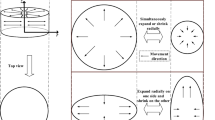Abstract
Compared with the conventional wire drawing process without ultrasonic vibration, which leads to high energy consumption and rough surface finish, the influences of longitudinal-torsional (L&T) composite ultrasonic vibration on titanium wire drawing process were investigated. The effects were discussed both numerically and experimentally in terms of friction force and stress, drawing force and stress, and processed wire surface quality. The analysis indicates that torsional ultrasonic vibration would increase the friction force in some extent, but only modestly, while longitudinal ultrasonic vibration is apparently beneficial to reducing the friction force in wire drawing process. Furthermore, both the longitudinal vibration and the L&T composite vibration are beneficial to decreasing the drawing force and improving the plastic deformation of titanium wires, especially for the latter. In addition, the longitudinal ultrasonic vibration could improve the surface quality of processed wires due to the friction force reduction. The L&T composite ultrasonic vibration could apparently reduce the drawing force as the result of its slight higher friction force within the contact area, which could provide the required plastic deformation energy at the cost of surface quality. The present research provides a new methodology for the ultrasonic titanium wire drawing process.
Similar content being viewed by others

References
Tang L, Du YT (2014) Experimental study on green electrical discharge machining in tap water of Ti-6Al-4V and parameters optimization. Int J Adv Manuf Technol 70:469–475
Ma JF, Andrus P, Condoor S, Lei ST (2015) Numerical investigation of effects of cutting conditions and cooling schemes on tool performance in up milling of Ti-6AL-4V alloy. Int J Adv Manuf Technol 78:361–383
Kumar J, Khamba JS (2010) Modeling the material removal rate in ultrasonic machining of titanium using dimensional analysis. Int J Adv Manuf Technol 48:103–119
Siegert K, Möck A (1996) Wire drawing with ultrasonically oscillating dies. J Mater Process Technol 60:657–660
Yao ZH, Kim GY, Faidley L, Zou QZ, Mei DQ, Chen ZC (2012) Effects of superimposed high-frequency vibration on deformation of aluminum in micro/meso-scale upsetting. J Mater Process Technol 212:640–646
Siddiq A, El Sayed T (2012) Ultrasonic-assisted manufacturing processes: variational model and numerical simulations. Ultrasonics 52:521–529
Liu JW, Baek DK, Ko TJ (2014) Chipping minimization in drilling ceramic materials with rotary ultrasonic machining. Int J Adv Manuf Technol 72:1527–1535
Blaha F, Langenecker B (1955) Tensile deformation of zinc crystal under ultrasonic vibration. Naturwissenschaften 42:556
Rasoli MA, Abdullah A, Farzin M, Fadaei Tehrani A, Taherizadeh A (2012) Influence of ultrasonic vibrations on tube spinning process. J Mater Process Technol 212:1443–1452
Siddiq A, El Sayed T (2011) Acoustic softening in metals during ultrasonic assisted deformation via CP-FEM. Mater Lett 65:356–359
Yao ZH, Kim GY, Faidley L, Zou QZ, Mei DQ, Chen ZC (2013) Acoustic softening and hardening of aluminum in high-frequency vibration-assisted micro/meso forming. Mater Manuf Process 28:584–588
Susan M, Bujoreanu LG, Galusca DG, Munteanu C, Mantu M (2005) On the drawing in ultrasonic field of metallic wires with high mechanical resistance. J Optoelectron Adv Mater 7:637–645
Hayashi M, Jin M, Thipprakmas S, Murakawa M, Hung JC, Tsai YC, Hung CH (2003) Simulation of ultrasonic-vibration drawing using the finite element method (FEM). J Mater Process Technol 140:30–35
Siegert K, Ulmer J (2001) Influencing the friction in metal forming processes by superimposing ultrasonic waves. CIRP Ann Manuf Technol 50:195–200
Shan XB, Qi HQ, Wang LL, Xie T (2012) A new model of the antifriction effect on the wiredrawing with ultrasound. Int J Adv Manuf Technol 63:1047–1056
Camacho AM, Domingo R, Rubio E, González C (2005) Analysis of the influence of back-pull in drawing process by the finite element method. J Mater Process Technol 164–165:1167–1174
Kumar VC, Hutchings IM (2004) Reduction of the sliding friction of metals by the application of longitudinal or transverse ultrasonic vibration. Tribol Int 37:833–840
Author information
Authors and Affiliations
Corresponding author
Rights and permissions
About this article
Cite this article
Yang, C., Shan, X. & Xie, T. Titanium wire drawing with longitudinal-torsional composite ultrasonic vibration. Int J Adv Manuf Technol 83, 645–655 (2016). https://doi.org/10.1007/s00170-015-7540-1
Received:
Accepted:
Published:
Issue Date:
DOI: https://doi.org/10.1007/s00170-015-7540-1


